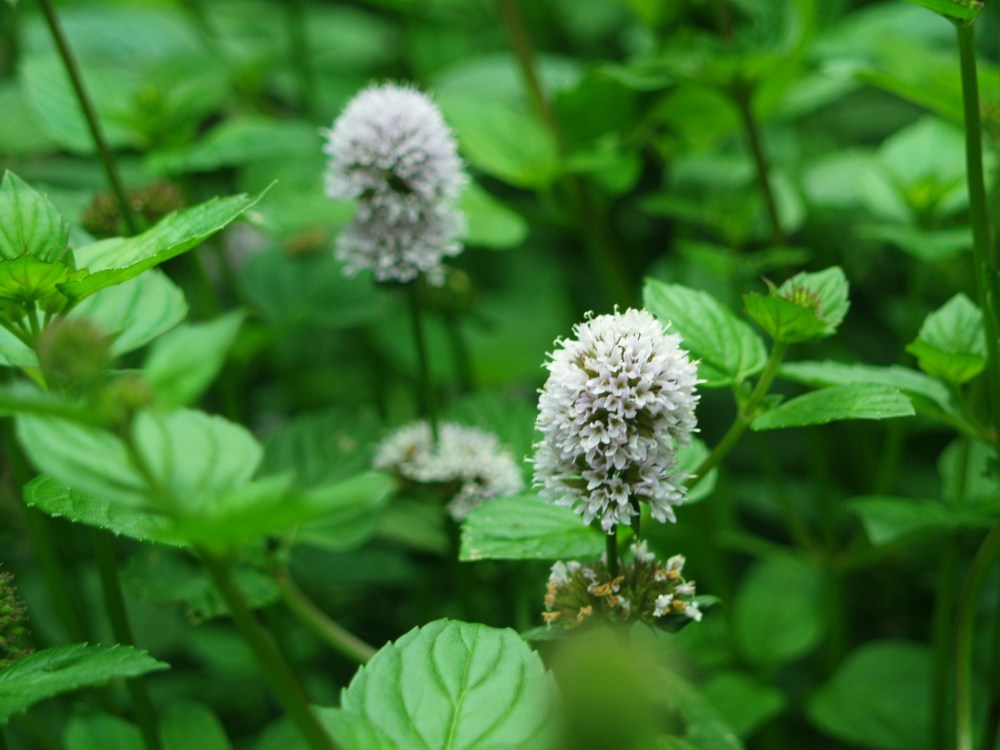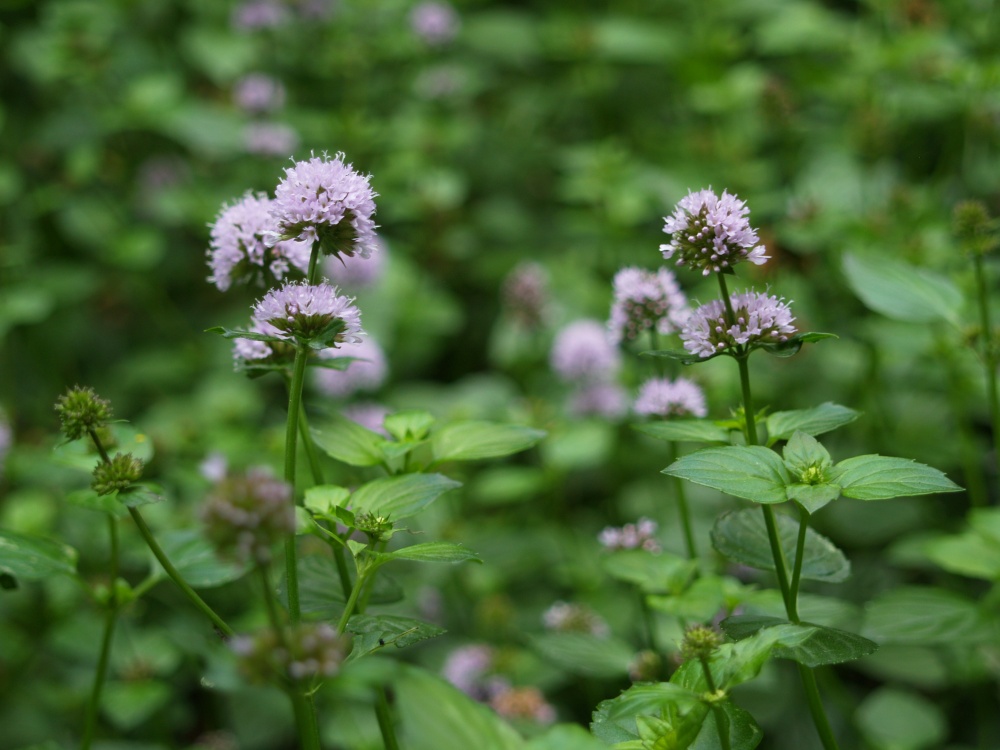I’ve been warned. Never, ever plant mint in your garden. Never. It’s too aggressive, I’m told, and once it’s planted it’s impossible to keep in bounds. Planting mint is an invitation to disaster.
I have little doubt that this is sound advice, but either I’m a skeptic or not a good listener (or a slow learner, or maybe all of the above), so a few years ago I planted a few small pots of Chocolate mint (Mentha x piperita subsp. citrata) in the damp depression where rainwater from neighboring lots flows into the wet weather pond I constructed at the back property line. This area stays damp for much of the year, and the pace of the stormwater continually eroded soil from this corner of the property. So, I figured what the heck, I need something aggressive to stabilize the soil and to root quickly so that the plants are not washed away in the next storm. Despite warnings to beware, I considered it worth a try.
In my stubbornness, I’ve ignored good advice and made mistakes before. Long ago, I planted Chameleon plant (Houttuynia cordata ‘Chameleon’, above), and have lived to tell about it, though I’ve done my best in recent years to eradicate it. Everywhere, that is, except the backside of this small retention pond where I was desperate to find a solution, any solution to survive the onslaught of weeds invading from the marshy meadow just beyond the property line. Houttuynia must be every bit as rambunctious as mint, but it smells worse (a lot worse), and I wouldn’t dare to recommend it. Planted at the edge of my first pond twenty years ago, its colorfully mottled foliage eventually faded mostly to green, then it grew to be downright unneighborly, overwhelming helpless victims in its path. So, a bit at a time, it’s been pulled and sprayed until little remains.
On the back of the pond Chameleon plant is sandwiched between tall crapemyrtles, woody shrubs, and vigorous brambles, so here it behaves as well as it’s capable of, and it has spread to keep weeds down satisfactorily. The mint is similarly constrained by a large evergreen magnolia and blueberries that tolerate the often wet soil, so that it is most unlikely to create major headaches. But, I can attest that it doesn’t give in without a fight, and the jury is still out whether it will create problems in the future. Will I bet that it’s not going to be a problem with the safeguards I think have been figured in? Maybe, yes.
In any case, for an area where erosion is a problem, and the the mint’s vigorous growth is acceptable, it seems to be a worthwhile risk. After a few years, the mint doesn’t show signs of escaping its confines, and there’s no doubt that it has stabilized the eroding soil. It also captures large debris that would eventually gum up the works in the pond. And, it looks and smells good. Even before the mint begins to flower in late summer, the foliage is pleasant enough, and in bloom it’s an exceptional tall ground cover. As long as it cannot escape.
Chameleon plant has roots that go to China and, if you leave even a fraction of a root behind, a new plant will grow. I know because have done battle with it. You have to be extremely diligent about removing the entire plant, roots and all.
I try to use herbicides as infrequently as possible, but I’ll be darned if I’m digging to China to get all the roots, so too often I’m forced to spray to be rid of Chameleon plant. The best remedy for most gardeners is to avoid planting it at all. Mint, we’ll see.
I have been battling Chameleon for the past 5 years. I must have gotten a piece of root of it in another plant from a garden club friend and have battled it ever since. I have painted it, sprayed it, pulled it, dug it, and cursed it. To no avail. My suggestion….just don’t plant it, and don’t share plants with others from that bed. It just isn’t worth taking the chance of giving it to someone else! I feel your pain!!
I frequently move perennials around, so I’ve moved Chameleon plant to a bunch of new spots. I usually try to ignore it for a year, but then it becomes a problem and more drastic action is required. I’ve been told that Chameleon plant is eaten in various countries in southeast Asia, and this is as good a reason as I’ve heard to find a McDonalds no matter where you are.
It must be like Limburger cheese, if you can get it passed your nose! Good luck!
What spray have you used for the Chameleon plant. I don’t want to harm the nearby pond or the plants it is growing through. I am now having the same problem with milkweed that suddenly appeared 2 years ago in another part of the garden! Help!
When I use an herbicide I use RoundUp, or another of the products with glyphosate. For soil based plantings this is the safest herbicide, but care must be taken to keep it out of ponds or streams where it could injure wildlife. A typical application on soil based plants is not a problem where you must be concerned about runoff, but directly spraying plants in water can be the issue. For plants near a body of water, but not in the water, you can apply glyphosate with a paint brush so that you avoid drift from the spray, although glyphosate is not highly toxic.
When I’ve had weeds growing in water I have hand pulled these rather than using an herbicide, so I don’t have experience with this. There are aquatic herbicides, but I believe that most are non-selective, so that they will kill all plant life in the water. I don’t know if glyphosate is labelled for application by the brush technique for plants growing in water. I suspect it would be effective, but it seems that some herbicide would move from the dying stems and roots into the water, so I’m guessing that it is not approved for this type application.
Thank you. Luckily, the weeds are not in the water yet, just around it. I have been afraid to use a spray, so I will try the paintbrush technique. I hope it works!!
I have hortitunia which I love, want to get rid of it? put down weed block for a couple of years, while you wait you can put potted plants on the weed block or mulch to hide it temporarily. some people swear by vinegar on plants, I noticed that if urine is put on plants it will kill it, don’t ask me how I do that. or just keep mowing it. where I have mine it can’t spread into the surrouding areas because it gets mowed down regularly. i have to mow anyway so it is not extra. there are other plants just as aggressive like goutweed (snow on the mountain) stripped grass, forest grass, and crab grass and others that are aggressive and not pretty like hortatunia.